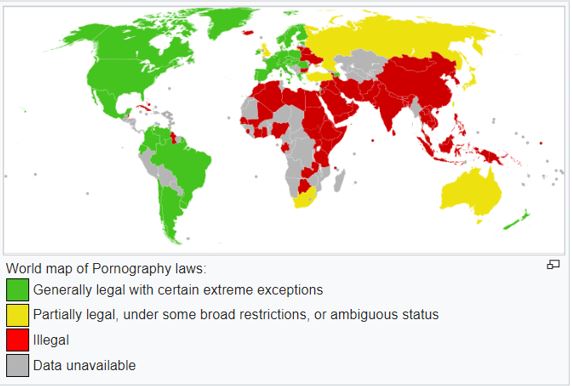Deepfake is technology to mimic humans in media, such as in photographs and videos. In fact, these algorithms are already so advanced it is impossible for a real human-being to notice that the content and persons are fully AI-generated. With a database of existing images and videos, machine learning techniques known as generative adversarial networks can generate these new sources of media from scratch in seconds. It has already been used to create fake news, fake celebrity videos or revenge porn (Alec Banks, 2018). These situations are without a doubt horrific. Apart from the very few creators, no one benefits from these activities that shake up stable societies.
The adult-video industry is made highly illegal by politics (arguably for good reasons) in many countries in Asia and Africa, resulting in fully blocked videos and photos, or censored genitals. Reasons for censorship is the dark and unwanted industry behind these videos, think of human trafficking, slavery, violence, crime and abuse. For end-users however, several studies conclude that liberalization of pornography in society is actually associated with decreased rape and other sexual violence (Anthony D’Amato, 2006), though other studies do find this effect, but not significant.
With AI-generated content, substantial monetary rewards can be made while positively impacting society. Namely, the dark industry behind these current videos is partially the reason for fully illegalizing it. So, if generative adversarial network technology results in friendly generated videos (just an algorithm and nothing else), current policies based on pornography with humans do not apply anymore. If in AI-generated content in which no person was ever involved, and is merely generated for end-users, should these videos then be allowed?
A world opens up for potential creators of media under a grey area of jurisdiction. Once that time may come, I expect that reaping the harvest seems the way to make quick and dirty money.
References
Banks, Alec. “Op-Ed | Deepfakes & Why the Future of Porn is Terrifying.” Available at: https://www.highsnobiety.com/p/what-are-deepfakes-ai-porn/
D’Amato, Anthony. “Porn up, rape down.” Original L. Rev. 2 (2006): 91. Available at: https://papers.ssrn.com/sol3/papers.cfm?abstract_id=913013


Hi Marc-Marijn,
Very nice to read about something that personally interest you. I am convinced that it deepfake is a very powerful instrument to use in various problems. However, I am raising concerns about the verification of deepfake adult entertainment. I think if your idea will becomes reality, who is able to tell whether a video is deepfake or not? Humans are not able to see the difference in deepfake.
I suppose that there should be a quality mark given to the deepfake videos in order to verify this. A centralized agency that is able to tell which videos are made with deepfake, based on the technical architecture of a video. But again, in an industry like adult entertainment, who can we trust and who not?
Another option would be that a centralized organization will create all deepfake adult entertainment. But can we trust a centralized organisation in creating all this content. A single organization creating these amounts of content could change behavior or opinions a many people in this world, given the size of this market.
Anyways, many bad things are happening in this industry that should be eliminated as soon as possible. Using deep fake for content production could be a sustainable substitute for this problem. Nice blog, definitely food for thought.